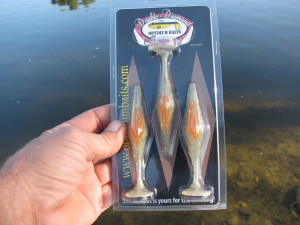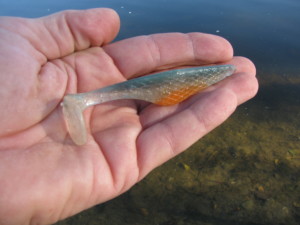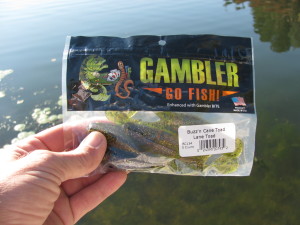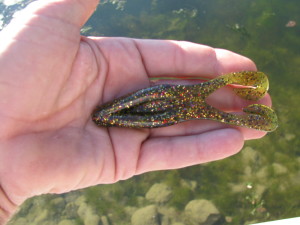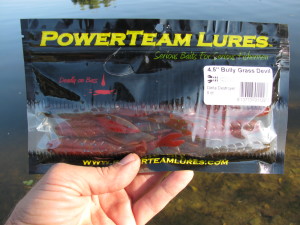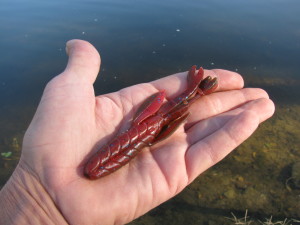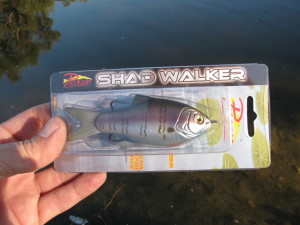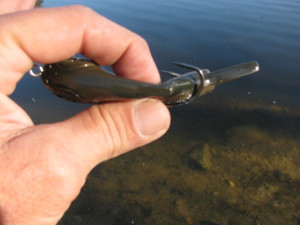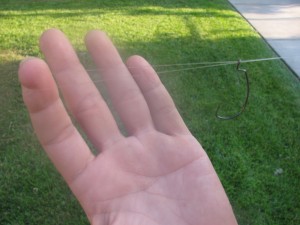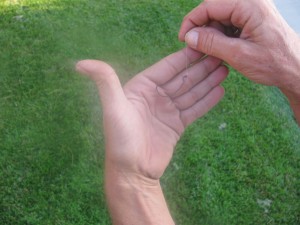If you’ve been with us for a while, you know that we always have a swimbait tied on when we hit the water. The reason is simple, they
catch fish and can be used in lots of different conditions. We are always open to trying a new product in this category and today’s review is on one that we have been experimenting with for a while, the Optimum Baits Double Diamond Swimmer.
We chose the 3.75 inch version for our testing because it matches the size of our local forage better than the other options. This version also lends itself to more possibilities for rigging than its larger cousins.
The Double Diamond Shape
It’s called the Double Diamond because of its shape. Both from the side and top or bottom, it is an elongated diamond with a small head and narrow section just in front of the oversized paddle tail. If you’re looking for 3D eyes, you won’t find them on this bait because the design of the head doesn’t allow space for eyes.
There is a belly slit in the bottom that isn’t as deep as one that is found on a split belly swimbait for aligning your hook whether you are rigging it weightless or using it as a jig trailer. However, because it is relatively shallow, you have more plastic to go through on the hook set than with more traditional swimbaits.
Rigging The Double Diamond
We started by rigging the Optimum on a 4/0 weighted EWG to see how it would cast and what the action would be like. The paddle tail does a good job of moving water but does have a sweet spot in terms of achieving the most kicking action. This bait will stay fairly horizontal on the retrieve without rising in the water column as fast as some of its competitors.
On the fall, the tail stops kicking but it does have a moderate nose down descent with no rolling to the side. We found in fishing the DD that a lot of our strikes occurred as we would snap the bait off the bottom and re-start our retrieve. As far as fishing it by itself, this proved to generate more strikes than any other retrieve we tried.
We also fished it as a trailer on both swim-jigs and chatter-baits. The design of this lure really lends itself to this rigging. Because of the shallow belly slit and fairly solid back, it seems to be more at home when threaded onto one of these baits so that your hook point can be exposed. We also found that it enhances the action of both of these products versus a craw style trailer in terms of the side to side kicking action.
When used like this, we only got strikes as the bait was moving. Not one occurred as the bait was sitting on the bottom. We had our best results by swimming this through stalks and lily pads. When we matched the colors of the Double Diamond to the colors of our jig skirts, we were hit more often than using either a complementary color or opposing colors.
There are a number of patterns available in the Optimum bait. They range from the subtle, more natural, to very dark as well as very bright giving you something that can be fished in almost any color water. Again, knowing the local forage should dictate which patterns you might want to try.
As far as cost goes, the Double Diamond will run about $4 bucks for three. While this isn’t cheap, it isn’t close to the most expensive soft plastic swimbait out there either. The durability of the DD is a little less than average mostly due to the narrow section of plastic just in front of the tail. It can be torn and was the weak link in our testing. However, it is also fairly versatile which comes in handy when you have to make adjustments while you’re on the water.
| Optimum Double Diamond Swimmer | |
|---|---|
| Overall Rating | |
| Unique design deserves a place in your tackle box | |
See ya’ on the water …
